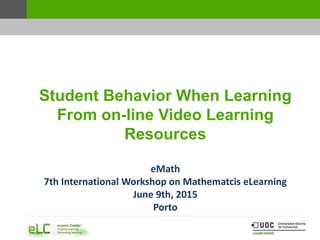Student Behavior When Learning From on-line Video Learning Resources
- 1. Student Behavior When Learning From on-line Video Learning Resources eMath 7th International Workshop on Mathematcis eLearning June 9th, 2015 Porto
- 2. The most exciting phrase to hear in science, the one that heralds the most discoveries, is not "Eureka!" (I found it!) but "That's funny..." Isaac Asimov Student Behavior When Learning From on-line Video Learning Resources
- 3. What we were trying to do To transfer self-explanations Context: Multimedia learning principles The worked-out example effect The self-explanation principle (Mayer, Moreno, Chi, Renkl...) We need to detect the good spontaneous self-explainers… not an easy task! The need for a learning analytics solution. (Alternatives: Guo, Kim et al., Chorianopoulos… even Microsoft) Student Behavior When Learning From on-line Video Learning Resources
- 4. Foto o grà fic o enllaç Student Behavior When Learning From on-line Video Learning Resources
- 5. The “boring ones” Student Behavior When Learning From on-line Video Learning Resources
- 6. M.I.A. Foto o gráfico Student Behavior When Learning From on-line Video Learning Resources
- 7. ?! Foto o gráfico Student Behavior When Learning From on-line Video Learning Resources
- 8. Yes, it can be complicated... Foto o gráfico Student Behavior When Learning From on-line Video Learning Resources
- 9. Segment by segment Foto o gráfico Student Behavior When Learning From on-line Video Learning Resources
- 10. Segment by segment Foto o gráfico Student Behavior When Learning From on-line Video Learning Resources
- 11. Skipper Foto o gráfico Student Behavior When Learning From on-line Video Learning Resources
- 12. Skippers Foto o gráfico Student Behavior When Learning From on-line Video Learning Resources
- 13. Rewinders Foto o gráfico Student Behavior When Learning From on-line Video Learning Resources
- 14. Rewinders Foto o gráfico César Córcoles Student Behavior When Learning From on-line Video Learning Resources
- 15. Browsers Foto o gráfico César Córcoles Student Behavior When Learning From on-line Video Learning Resources
- 16. What remains to be done? An awful lot! •To gather more data from more videos of more different types (volunteers?) •To automate and improve data gathering and reporting (one final project, some minimal financing, institutional interest) •To act on detected expected (and unexpected!) behaviors •To leverage the technology. An infinite array of possibilities Student Behavior When Learning From on-line Video Learning Resources
- 17. Thank you! Obrigado! ¡Gracias! Grà cies! César Córcoles http://teking.uoc.edu ccorcoles@uoc.edu Student Behavior When Learning From on-line Video Learning Resources
Editor's Notes
- L’estudiant segueix amb aquest patrĂł fins arribar a 290, veu deu segons, salta amb el mateix patrĂł fins a 516, veu dos minuts i mig, fa una pausa de 30 segons i segueix amb aquest segon patrĂł fins al final del vĂdeo
- L’estudiant segueix amb aquest patrĂł fins arribar a 290, veu deu segons, salta amb el mateix patrĂł fins a 516, veu dos minuts i mig, fa una pausa de 30 segons i segueix amb aquest segon patrĂł fins al final del vĂdeo
- L’estudiant segueix amb aquest patrĂł fins arribar a 290, veu deu segons, salta amb el mateix patrĂł fins a 516, veu dos minuts i mig, fa una pausa de 30 segons i segueix amb aquest segon patrĂł fins al final del vĂdeo
- L’estudiant segueix amb aquest patrĂł fins arribar a 290, veu deu segons, salta amb el mateix patrĂł fins a 516, veu dos minuts i mig, fa una pausa de 30 segons i segueix amb aquest segon patrĂł fins al final del vĂdeo
- L’estudiant segueix amb aquest patrĂł fins arribar a 290, veu deu segons, salta amb el mateix patrĂł fins a 516, veu dos minuts i mig, fa una pausa de 30 segons i segueix amb aquest segon patrĂł fins al final del vĂdeo
- L’estudiant segueix amb aquest patrĂł fins arribar a 290, veu deu segons, salta amb el mateix patrĂł fins a 516, veu dos minuts i mig, fa una pausa de 30 segons i segueix amb aquest segon patrĂł fins al final del vĂdeo
- L’estudiant segueix amb aquest patrĂł fins arribar a 290, veu deu segons, salta amb el mateix patrĂł fins a 516, veu dos minuts i mig, fa una pausa de 30 segons i segueix amb aquest segon patrĂł fins al final del vĂdeo

















